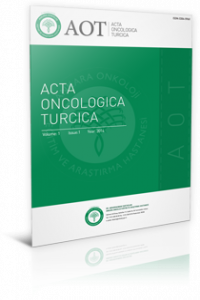Thromboembolic Complications of Cancer and Management
Kanser, tromboemboiizm.
Kanserin Tromboembolik Komplikasyonları ve Tedaviye Yönelik Yaklaşımlar
Cancer, thromboembolism.,
___
- Khorana AA, Francis CW, Culakova E, Kuderer NM, Lyman GH. Frequency, risk factors and trends for venous thrombo- embolism among hospitalized cancer patients. Cancer 2007;110:2339-46.
- Blom JW, Doggen CJ, Osanto S, Ftoserıtaal FR. Malignancies, protrombotic mutations, and the risk o f venous thrombosis. JAMA 2005;293:715-22.
- Casiato DA. Hematologic complications. İn: Casiato DA, Territo MA (eds). Manual of Clinical Oncotogy. 5th ed. Philadelphia: Lippincott VVilliams & VVilkins, 2004:651-3.
- Khorana AA, Francis C\N, Blumberg N, Culakova E, Refaai MA, Lyman GH. Blood transfusion, thrombosis, and morta- lity in hospitalized patients with cancer. Arch Intern Med 2008;168:2377-81.
- Geerts W, Pineo G, Heit JA, et al. Prevention of venous thromboembolism, the seventh ACCP conference on antith- rombotic and thrombolytic therapy. Chest2004;126:338-400.
- Şamama M, Cohen A, Darmon JY, et al. A comparison of endoxaparin with placebo for prevention of venous throm boembolism in acutely ili medical patients. N Engl J Med 1999;341:739-800.
- Leizorovicz A, Cohen AT, TurpieAG, et al; PREVENT medi cal thromboprophylaxis study group. A randomized, place- bo-controlled trial of deltaparin for the prevention of venous thromboembolism in acutely ili medical patients. Circulation 2004;110:874-9.
- Cohen A, Davidson B, Gallus A, et al. ARTEMIS investiga- tors. Efficacy and safety of fondaparinux fort the prevention of venous thromboembolsim in older acute medical patients randomized placebo controlled trial. BMJ 2006;332:335-29.
- ENOXACAN Study Group. Efficacy and safety of enoxapa- rin versus unfractionated heparin for prevention of deep vein thrombosis in elective cancer surgery: A double-blind randomized multicentre trial with venographic assessment. B rJS urg 1997;84:1099-103.
- Bergqvist D, Angelli G, Cohen AT. Duration of prophylaxis agaist venous thromboembolism with enoxaparin after sur gery for cancer. N Engl J Med 2002;346:975-80.
- Agnelli G, Bergçvist D, Cohen AT, Gallus /4S, Gent M. PEGASUS investigators. Randomized clinical trial of posto- perative fondaparinux versus perioperative deltaparin for prevention of venous thromboembolism in high-risk abdo- minal surgery. Br J Surg 2005;92;10:1212-20.
- Levine M, Hirsh J, Gent M, et al. Double-blind randomized trial of a very low dose warfarin for prevention of thromboem- bolism in stage IV breast cancer. Lancet 1994;343:886-9.
- Haas SK. Prevention of venous thromboembolism with low- molecular weight heparin in patients metastatic breast or lung cancer: Results of TOPIC studies. J Thromb Haemost 2008:(Suppl 1);3.
- Couban S, Goodyear M, Burnell M, et al. Randomized pla- cebo controlled study of low-dose warfarin fort the preventi on of Central venous catheter-associated thrombosis in pati ents with cancer. J Clin Oncol 2005; 23:4063-2.
- Karthaus M, Kretzschmar A, Kröning H, et al. Deltaparin for prevention of catheter-related complications in cancer pati ents with Central venous catheters: Final results of a doub le-blind, placebo-controlled phase III trial. Ann Oncol 2006;17:289-96.
- Prandoni P, Lensing AW, Piccoli A, et al. Recurrent venous thromboembolism and bleeding complications during anti- coagulant treatment for patients with cancer and venous thrombosis. Blood 2002;100:3484-8.
- Hutten BA, Prins MH, Gent M. Incidence of recurrent throm- boembolic and bleeding complications among patients with venous thromboembolism in relation to both malignancy and achieved International normalized ratio: A retrospective analysis. J Clin Oncol 2000;18:3078-83.
- Yildirim Y, Ozyilkan O, Akçalı Z, Basturk B. Drug interaction between capecitabine and warfarin: A case report and revi- ew of the literatüre. Int J Clin Oncol 2006;44:80-2.
- Lee AY, Levine MN, Baker Rl, et al. Low-molecular weigth heparin versus a coumarin for the prevention of recurrent venous thromboembolism for patients with cancer. N Engl J Med 2003;349:146-53.
- Meyer G, Marjanovic Z, Valcke J,et al. Comparison of low molecular vveight heparin and warfarin for the secondary prevention of venous thromboembolism for patients with cancer. Arch Intern Med 2002;162:1729-35.
- Kakkar AK, Levine MN, Kadziola Z, et al. Low molecular vveight heparin, therapy with deltaparin and survival in advanced cancer. The fragmin advanced malignancy outco- me study (FAMOUS). J Clin Oncol 2004;22:1944-8.
- Kearon C, Kahn SR, Angelli G, Goldhaber S, Raskob GE, Comerota AJ. Antithrombolitic therapy for venous thrombo- embolic disease: American College of Chest Physicians Evidence-Based Clinical Practice Guidelines (8th ed). Chest 2008;133:454-545.
- ISSN: 0304-596X
- Başlangıç: 2015
- Yayıncı: Dr. Abdurrahman Yurtaslan Ankara Onkoloji EAH
Gülbahar GÜLNERMAN, Selma KELEŞ, Menşure KAYA, Neslihan KURU, Nihal KADIOĞULLARI
Primary Lung Cancer vvith Invasion Into the Atrium: Two Case Report
Nazan ÇİLEDAĞ, Pelin DEMİR GÜMÜŞDAĞ, Elif AKTAŞ, Kemal ARDA
Kaposi Sarcoma Presented on Glans Penis
Tolga TUNCEL, Ahmet ALACACIOĞLU, Bülent KARAGÖZ, Oğuz BİLGİ, Alpaslan ÖZGÜN, Zafer KÜÇÜKODA, Emin Gökhan KANDEMİR
Thromboembolic Complications of Cancer and Management
Yeşim YILDIRIM, Özgür ÖZYILKAN
A Case of Schvvannoma Arising from Brachial Plexus
Hayriye KARABULUT, Baran ACAR, Mehmet Ali BABADENİZ, Gülçin ŞİMŞEK, Emre GÜNBEY
Renal Celi Carcinoma in an Ectopic Kidney: Case Report
Niyazi KARAMAN, Lütfi DOĞAN, Cihangir ÖZASLAN, Can ATALAY, Çiğdem IRKKAN, Asuman BOZKURT
Multidedector Computed Tomography Findings of Crohn 's Disease
Ultrasonography Guided Pancreatic Needle Biopsies
Bilgin Kadri ARIBAŞ, Gürbüz DİNGİL, Ümit ÜNGÜL, Gürsel ŞAHİN, Dilek Nil ÜNLÜ, Kamil DOĞAN, Sevim ÖZDEMİR, Zekiye PEKOL ŞİMŞEK, Aliye Ceylan ZARALI, Rasime Pelin DEMİR, Kemal ARDA
Clinicopathological Characteristics of Ninety MaHgnant Melanoma Patients
Mutlu DOĞAN, Ülkü YALÇINTAŞ ARSLAN, Saadet TOKLUOĞLU, Güze ÖZAL, Hande SELVİ, Güngör UTKAN, Hakan AKBULUT, Bülent YALÇIN, Necati ALKIŞ, Fikri İÇLİ
Surgical Breast Biopsies and Complications: Is There an Effect on Future Treatments?
Lutfi DOĞAN, Niyazi KARAMAN, Cihangir ÖZASLAN, Can ATALAY, Mehmet ALTINOK
